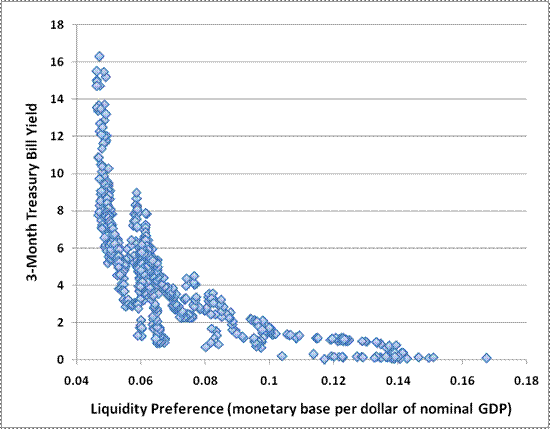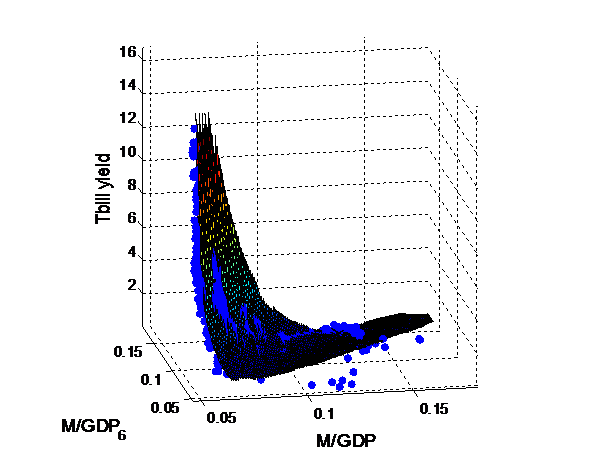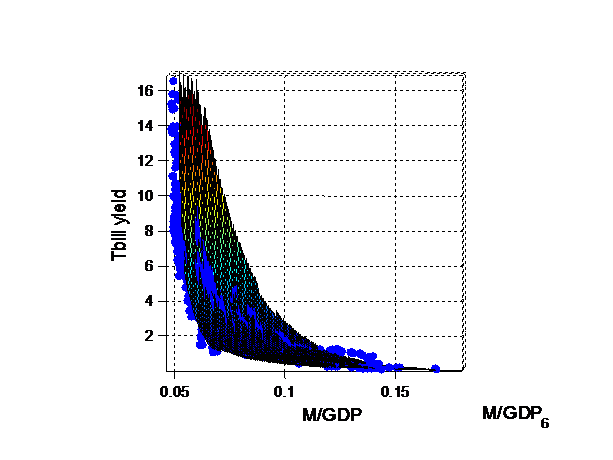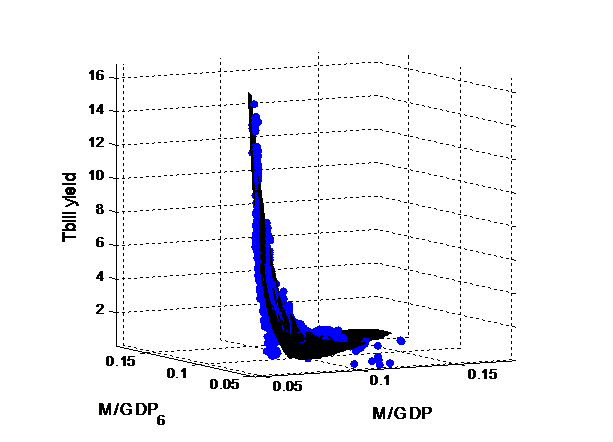This is one of the reasons that I am convinced that much higher inflation is coming. If the Fed doesn't reverse its purchases of Treasuries, it will create a cash "hot potato" that will ignite rampant inflation. And if it does, who will want to buy all those treasuries, and what will be the impact on the broader economy of much higher interest rates? And if they can't accomplish this quickly enough, while maintaining a balance between these variable, then what could the the (unintended) consequences? I think that the result will be more monetary mayhem, and the likelihood is toward much higher inflationary pressures. That "hot potato" could bring hyperinflation!
John Hussman at Hussman Funds:
One of the most important factors likely to influence the financial markets over the coming year is the extreme stance of U.S. monetary policy and the instability that could result from either normalizing that stance, or failing to normalize it. It is not evident that quantitative easing, even at its present extremes, has altered real GDP by more than a fraction of 1% (keep in mind that commonly reported GDP growth rates are quarterly changes multiplied by 4 to annualize them). Moreover, it's well established - on the basis of both U.S. and international data - that the "wealth effect" from stock market changes is on the order of 0.03-0.05% in GDP for every 1% change in stock market value, and the impact tends to be transitory at that.
Still, by replacing an enormous quantity of interest-bearing assets with non-interest bearing money, quantitative easing has created profound distortions in asset prices, where Treasury bills now yield less than 5 basis points annually, while "risk assets" such as stocks and commodities have been driven to prices high enough that their likely future returns now compete perfectly (on a time-horizon and risk-adjusted basis) with the zero expected returns on cash.
Taken together, despite the limited and transitory real effects of QE on output and employment, the Federal Reserve has created an unprecedented monetary position that creates an extremely unstable equilibrium for the financial markets. There are several ways that this might be resolved. Based on the very robust relationship between short-term interest rates and the monetary base, it is clear that a normalization of short-term interest rates, even to 0.25-0.50%, would require the Federal Reserve to fully reverse the $600 billion of asset purchases it conducted under QE2. Alternatively, with the monetary base now exceeding 16 cents for every dollar of nominal GDP, any external upward pressure on interest rates (that is, not produced by a Fed-initiated reduction in the monetary base) would quickly provoke inflationary pressures.
Last week, my friend John Mauldin reprinted our April 11 market comment
Charles Plosser and the 50% Contraction in the Fed's Balance Sheet . John told me that he had received several nearly identical questions, along the lines of "Wait, now I'm confused - I thought that the Fed
reduces inflation pressures by raising interest rates. Why would higher interest rates trigger inflation?"
So, this is where that phrase "external upward pressure" comes in. We have to distinguish between what economists would call an "endogenous" increase in interest rates - one that the Fed itself provokes by reducing the monetary base - and an "exogenous" increase in interest rates - one that is produced by changes in the behavior of investors and the economy, independent of actions by the Fed.
See, when the Fed decides to raise interest rates, it does so by reducing (or slowing the growth) of the monetary base, which can reasonably be viewed as an "anti-inflationary" policy. However, if interest rates rise independent of any change in the monetary base, then cash - which doesn't bear interest - becomes a "hot potato" that is suddenly less desirable. Somehow, the excess cash has to be "absorbed" in the sense that someone becomes willing to hold it despite the higher interest rates. Unless real output expands sufficiently to absorb that cash, you get one of two alternative outcomes: people holding cash may bid up Treasury bills, lowering short-term interest rates to the point where people are again indifferent between cash and non-cash alternatives, or failing that, the attempt to get rid of cash holdings in other ways provokes inflation and a depreciation in the foreign exchange value of the dollar (which was the outcome in the 1970's).
As I've argued elsewhere, one of the primary sources of exogenous inflationary pressure is growth in unproductive forms of government spending (spending that creates demand but does not expand capacity or incentive to produce), but I'll leave that feature of the argument for another time.
Monetary Policy in 3-D
The extreme stance of monetary policy is such a critical factor in the financial markets here that it is worth spending a bit more time on the relationship between interest rates, inflation, and the monetary base.
Let's return to the concept of "liquidity preference" - basically the "demand curve" for base money (currency and bank reserves). To make this operational, we define liquidity preference as the amount of base money that individuals choose to hold per dollar of nominal GDP, given any particular level of short-term interest rates. The chart below shows this "demand curve" for money in monthly data since the 1940's. Notice that when interest rates are high, there is a significant "opportunity cost" to holding base money, so people cut back on the balances they hold. When interest rates are low, people are willing to hold a greater amount of non-interest bearing money per dollar of GDP.

What's critical about liquidity preference is this - while there are numerous combinations of T-bill yields, monetary base, and nominal GDP that will produce equilibrium (demand for money = supply of money), the three variables are "jointly constrained." For example, suppose that there is upward pressure on interest rates which reduces the attractiveness of non-interest bearing cash. If the Federal Reserve does not reduce the monetary base sufficiently to move left to the appropriate point on the "demand curve," the burden of adjustment is instead thrown onto nominal GDP. Since variations in real GDP have a fairly limited range, the majority of that adjustment is forced to take the form of price increases (i.e. inflation) sufficient to bring the ratio of the monetary base to GDP down to the appropriate level.
Similarly, if the Fed creates a great deal of base money, and the components of nominal GDP (real GDP and prices) are fairly "sticky", short-term interest rates will decline to a level sufficient to ensure that the additional money is held (this has been essentially the story of QE2).
If you like equations (if not, skip this paragraph), by our estimates, about 96% of the historical variation in U.S. money demand is described by a fairly simple equation relating the Treasury bill yield ("i") and the amount of monetary base per dollar of nominal GDP (M/PY): i = exp(4.25 - 129.87*M/PY + 84.42*M/PY_lagged_6_mos). In some of the recent pieces I've written, I've used the "steady state" of this equation, which is i = exp(4.27 – 45.5*M/PY). See the original "
Sixteen Cents" piece for further details.
Below, I've plotted this liquidity preference relationship as a 3-dimensional surface. This is essentially the "policy surface" faced by the Federal Reserve. Nearly all of the historical data is captured by periods where the amount of monetary base per dollar of GDP changed by less than 1 cent either way over any 6-month period. The blue marbles on the graph represent actual data points since the 1940's. The marbles on the floor along the right side of the graph aren't technically off the policy surface, but are clearly outliers because of the abrupt shift in monetary base per unit of GDP that occurred between 6-month periods during the recent financial crisis, which were associated with a plunge in interest rates toward zero.

As should be evident, the historical liquidity preference relationships we've been discussing are very tight. This is why I am so adamant that quantitative easing is an irresponsible policy - we
know how these variables are related. Specifically, it will be nearly impossible to normalize interest rates, even slightly, without a massive contraction in the Fed's balance sheet. Likewise, as we approach 17 cents of monetary base per dollar of nominal GDP, even the slightest exogenous interest rate pressure will imply the need for massive reversals in the monetary base in order to avoid steep inflationary pressures. My hope is that my previous comment
Will the Real Phillips Curve Stand Up? makes it clear that there is very little "tradeoff" between unemployment and
general price inflation.
Since a picture is often worth a thousand words, I've included a few additional perspectives of the "policy surface" that the Federal Reserve faces here. The chart below is a head-on view. The point at the far right shows the present stance of monetary policy. Charles Plosser of the Philadelphia Fed is quite correct that normalizing interest rates to about 2.5% would imply a reduction of nearly 50% in the Fed's balance sheet, but as I noted two weeks ago, the required cutback in the balance sheet is extremely front-loaded, as a non-inflationary move to a Fed Funds rate of just 0.25% would require a reduction in the monetary base from about 17 cents to less than 13 cents per dollar of GDP, taking the monetary base from $2.6 trillion to less than $2 trillion - effectively reversing QE2 in its entirety.

The following chart shows the policy surface, along with actual data points, from the origin. We are now way out on the flat part of the curve. Again, in order to achieve even a slight endogenous increase in interest rates, the Fed will have to reduce the monetary base sharply. Alternatively, in order to offset the inflationary pressure from a slight exogenous increase in interest rates, the Fed would be forced to respond with a sharp tightening in its balance sheet. Both normalizing policy, and failing to normalize it, now present the economy and the financial markets with hazards that, in my view, were needless in the first place.

As a final note, the Fed does have an additional policy tool - the ability to pay interest on bank reserves, in hopes of preventing base money from becoming an inflationary "hot potato." The difficulty here is that the Fed's balance sheet is now leveraged 51-to-1. Even 0.25% of annual interest on reserves works out to about 12% of the Fed's total capital. The Fed is already in a position where a 35 basis point increase in long-term interest rates would effectively wipe out that capital. Though the Fed does earn interest on the Treasury debt it holds (which is remitted back to the Treasury for public uses), it would still take an increase in long-term interest rates of less than 1% to wipe out the Fed's capital as well as its entire net interest margin. So while the Fed might have the latitude to pay another 0.25% of interest on reserves, every extension of its present policy course, be it more quantitative easing, or paying interest on existing bank reserves, substantially increases its already untenable level of balance sheet leverage, and the likelihood that the public will quietly need to subsidize that balance sheet.




